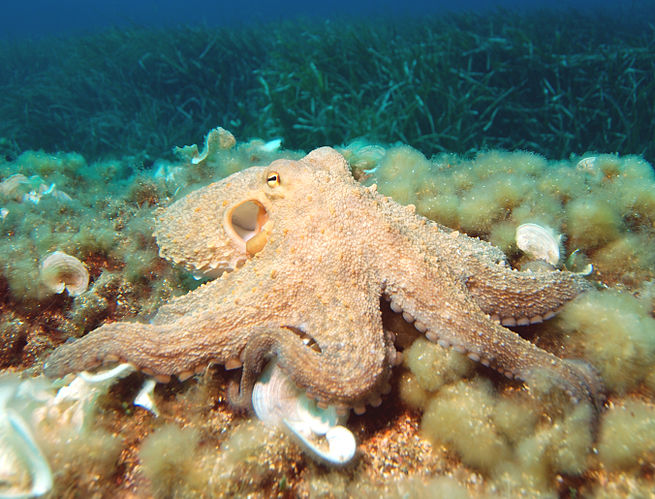Main Difference
The main difference between Octopus and Jellyfish is that the Octopus is a order of molluscs and Jellyfish is a soft-bodied, aquatic invertebrates
-
Octopus
The octopus is a soft-bodied, eight-limbed mollusc of the order Octopoda. Around 300 species are recognised, and the order is grouped within the class Cephalopoda with squids, cuttlefish, and nautiloids. Like other cephalopods, the octopus is bilaterally symmetric with two eyes and a beak, with its mouth at the center point of the eight limbs (traditionally called “arms”, sometimes mistakenly called “tentacles”). The soft body can rapidly alter its shape, enabling octopuses to squeeze through small gaps. They trail their eight appendages behind them as they swim. The siphon is used both for respiration and for locomotion, by expelling a jet of water. Octopuses have a complex nervous system and excellent sight, and are among the most intelligent and behaviourally diverse of all invertebrates.
Octopuses inhabit various regions of the ocean, including coral reefs, pelagic waters, and the seabed; some live in the intertidal zone and others at abyssal depths. Most species grow fast, mature early and are short-lived. During breeding, the male uses a specially adapted arm to deliver a bundle of sperm directly into the female’s mantle cavity, after which he becomes senescent and dies. The female deposits fertilised eggs in a den and cares for them until they hatch, after which she also dies. Strategies to defend themselves against predators include the expulsion of ink, the use of camouflage and threat displays, their abilities to jet quickly through the water and hide, and even through deceit. All octopuses are venomous, but only the blue-ringed octopuses are known to be deadly to humans.
Octopuses appear in mythology as sea monsters like the Kraken of Norway and the Akkorokamui of the Ainu, and probably the Gorgon of ancient Greece. A battle with an octopus appears in Victor Hugo’s book Toilers of the Sea, inspiring other works such as Ian Fleming’s Octopussy. Octopuses appear in Japanese erotic art, shunga. They are eaten and considered a delicacy by humans in many parts of the world, especially the Mediterranean and the Asian seas.
-
Jellyfish
Jellyfish and sea jellies are the informal common names given to the medusa-phase of certain gelatinous members of the subphylum Medusozoa, a major part of the phylum Cnidaria. Jellyfish are mainly free-swimming marine animals with umbrella-shaped bells and trailing tentacles, although a few are not mobile, being anchored to the seabed by stalks. The bell can pulsate to provide propulsion and highly efficient locomotion. The tentacles are armed with stinging cells and may be used to capture prey and defend against predators. Jellyfish have a complex life cycle; the medusa is normally the sexual phase, the planula larva can disperse widely and is followed by a sedentary polyp phase.
Jellyfish are found all over the world, from surface waters to the deep sea. Scyphozoans (the “true jellyfish”) are exclusively marine, but some hydrozoans with a similar appearance live in freshwater. Large, often colorful, jellyfish are common in coastal zones worldwide. The medusae of most species are fast growing, mature within a few months and die soon after breeding, but the polyp stage, attached to the seabed, may be much more long-lived. Jellyfish have been in existence for at least 500 million years, and possibly 700 million years or more, making them the oldest multi-organ animal group.Jellyfish are eaten by humans in certain cultures, being considered a delicacy in some Asian countries, where species in the Rhizostomae order are pressed and salted to remove excess water. They are also used in research, where the green fluorescent protein, used by some species to cause bioluminescence, has been adapted as a fluorescent marker for genes inserted into other cells or organisms. The stinging cells used by jellyfish to subdue their prey can also injure humans. Many thousands of swimmers are stung every year, with effects ranging from mild discomfort to serious injury or even death; small box jellyfish are responsible for many of these deaths. When conditions are favourable, jellyfish can form vast swarms. These can be responsible for damage to fishing gear by filling fishing nets, and sometimes clog the cooling systems of power and desalination plants which draw their water from the sea.
-
Octopus (noun)
Any of several marine molluscs/mollusks, of the family Octopodidae, having no internal or external protective shell or bone (unlike the nautilus, squid or cuttlefish) and eight arms each covered with suckers.
-
Octopus (noun)
The flesh of these marine molluscs eaten as food.
-
Octopus (noun)
An organization that has many powerful branches controlled from the centre.
-
Jellyfish (noun)
An almost transparent aquatic animal; any one of the acalephs, especially one of the larger species, having a jellylike appearance.
-
Jellyfish (noun)
A cnidarian, a member of the phylum Cnidaria.
-
Jellyfish (noun)
A scyphozoan, a member of the class Scyphozoa (the true jellies).

